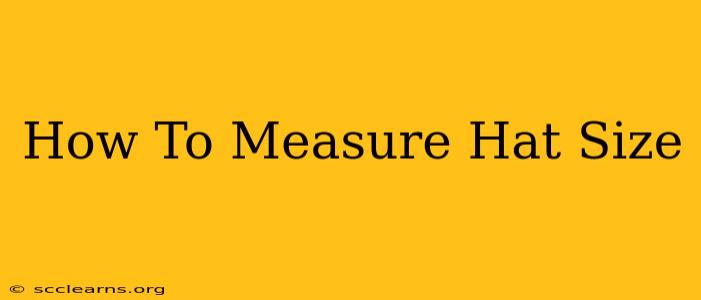Finding the perfect hat can be tricky. Too small, and it's uncomfortable. Too big, and it slips off. The key to avoiding hat-related headaches? Knowing your hat size! This comprehensive guide will walk you through how to accurately measure your hat size, ensuring a perfect fit every time.
Why Knowing Your Hat Size Matters
Before we dive into the measurement process, let's understand why knowing your hat size is crucial. Simply guessing won't cut it. An ill-fitting hat can be:
- Uncomfortable: A hat too tight can cause headaches and discomfort, while a hat too loose will constantly need readjustment.
- Unattractive: A poorly fitting hat can ruin an otherwise great outfit.
- Unsafe: In some cases, like with helmets or safety hats, an incorrect size can compromise safety.
Accurate measurement ensures you get the right fit, leading to comfort, style, and, in certain situations, safety.
Methods for Measuring Your Hat Size
There are two primary methods for determining your hat size: measuring your head circumference and using an existing hat that fits well.
Method 1: Measuring Your Head Circumference
This is the most accurate method for determining your hat size. You'll need a flexible tape measure (a soft fabric one is ideal). Here's how to do it:
- Find the right spot: Place the tape measure around your head, about ½ inch above your eyebrows and ears. This is the widest part of your head.
- Measure accurately: Ensure the tape measure is snug but not tight. Avoid pulling it too tightly, as this will result in an inaccurate measurement.
- Record your measurement: Note the measurement in inches or centimeters. Most hat sizing charts use inches.
Method 2: Using a Well-Fitting Hat
If you already own a hat that fits perfectly, you can use it to determine your hat size. Here's what to do:
- Lay it flat: Lay the hat flat on a table.
- Measure the inside circumference: Use a tape measure to measure the inside circumference of the hat, along the headband.
- Note the size: Compare your measurement with a hat size chart to determine your hat size.
Important Note: Remember that hat sizes can vary slightly between brands and styles. It's always a good idea to check the size chart provided by the specific hat manufacturer or retailer.
Understanding Hat Sizing Charts
Hat size charts translate your head circumference measurement into a hat size. These charts often use numerical sizes (e.g., 6 ¾, 7, 7 ¼) or alphabetical sizes (e.g., S, M, L, XL). The numerical sizes represent inches, while alphabetical sizes provide a more general range.
Always consult the size chart for the specific brand and style of hat you are purchasing. Don't rely on a generic chart; sizes can vary significantly.
Tips for a Perfect Fit
- Consider the hat style: Some hat styles, like beanies or baseball caps, are more forgiving than others, like fitted hats or fedoras.
- Try before you buy (if possible): If you can try a hat on before purchasing, always do so! This is the best way to ensure a perfect fit.
- Check return policies: Familiarize yourself with the retailer's return policy in case the hat doesn't fit perfectly.
By following these steps, you'll be able to accurately measure your hat size and confidently purchase hats that fit perfectly, ensuring comfort and style. Now go forth and find your perfect hat!

